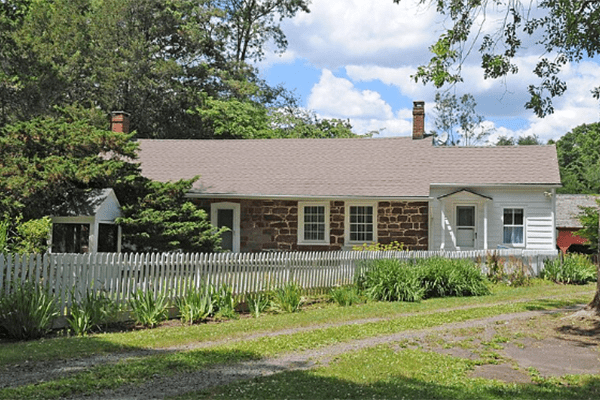|
RCBJ-Audible (Listen For Free)
|
The Pre-Revolutionary War Era Peter DePew House Is A Relic, As Is Its Large Tract Of Farmable Land; Homeowner Donna Schwartz Is Hoping Rockland County Will Buy & Preserve Homestead
By Tina Traster
Donna Schwartz and her older sister Carol grew up in a grand two-story brick house in Spring Valley, but their mother hankered for a farmhouse and a “back forty” as development devoured the town.
Jessie and Irving Keesler found their slice of paradise not too far away in New City – still a largely agrarian swath of farms that harkened to Rockland County’s past. The Keeslers in 1958 purchased a pre-Revolutionary sandstone house with 32 acres of partially cultivated land that stretched back to the Blauvelts and before that the DePews – two of the county’s legacy families. They paid the estate of Mary E. Blauvelt $45,000 for the wreck.
It took more than five years to make the then-vacant house that was in a shambles a habitable home. By then Schwartz had left for college but the family homestead played a significant role as a palette for her mother’s fertile creativity, a lifelong project for her father, and a gathering spot for the family for holidays and special occasions.
“The house became the love of my mother’s life and my father learned to love it,” said Schwartz, wistfully. “My mother saw the beauty. It was a diamond in the rough.”
Now Schwartz is hoping Rockland County will recognize this diamond in the rough as a preservation opportunity, given that most of the county’s pre-Revolutionary homes have disappeared, as has the bulk of its farm land. The Rockland Farm Alliance has nominated the house for the county’s Open Space Acquisition Program. Nominations closed in November, and the county is considering 12 applicants under the Open Space Acquisition Program. The county has roughly $9.5 million in its Open Space Acquisition budget but some of those monies may already be appropriated for the properties “still moving through the process,” from the prior round, according to the county spokesperson.
“This is one of the last remaining parcels that is not only farmable but is a classic, historic property,” said John McDowell, president of the Rockland Farm Alliance, which has nominated the property for open space. “We can’t pass this up. These opportunities are few in the county, and it’s prime for open space. It’s large and beautiful with a 1700s house and an historic barn.”
The Peter DePew House, as it’s known, is listed on the National Register of Historic Places, and was built sometime between 1750 and 1780. The one-and-a-half story sandstone structure on Old Route 304, is located east of Zukor Road and close to the Jacob Blauvelt House, home of the Rockland County Historical Society. Its Hudson Valley 18th-century vernacular architecture, particularly its sandstone masonry, exemplifies the workmanship of the county’s early Dutch inhabitants. The house is included in the definitive survey of Pre-Revolutionary Dutch Houses and Families in Northern New Jersey and Southern New York, written by Rosalie F. Bailey in 1936. The author dated the house to William Campbell in 1713 when it was part of a 300-acre tract. Eventually the house was passed along to the DePews, and then sold to the Blauvelt family, which kept the house in the family until mid 19th-century.
The property sits in the Town of Clarkstown’s R-160 (Conservation Zone) which limits a buyer’s ability to develop or subdivide the property. The R-160 Conservation Density Residence District was established to provide protection to the town’s scenic resources, including streams, wooded-areas, steep slopes, large open spaces, and scenic vistas, by controlling and limiting development in that zone. The property is also designated as “Historic” on the Town’s Zoning Map.
A few months ago, Schwartz put the house on the market for $3 million – not because she wanted to but because it was part of a legal settlement with family members. Her sister, in her late 80s, lives in a care facility in Connecticut.
“I didn’t want to sell it; it meant so much to both my sister and me,” said Schwartz. “I wanted to hold onto it. Pass it down to my grandchild. But I was forced. I had no choice.” Schwartz said the legal case impacted her emotionally and physically.
Before the legal wrangling began, Schwartz undertook an extensive house renovation, which she completed last year. The house’s wide-planked wood floors and exposed structural beams pay homage to its past, but the house has been fully updated. There is a two-story timber-framed barn and several sheds and outbuildings.
Though the house is listed for sale for $3 million – and there has been interest according to the broker – Schwartz is hoping the county will purchase and preserve the land, or a private sale will be contingent upon farmland preservation. The homeowner has leased part of the farm to a Christmas tree grower for many years.
Historical records from the 1850s agricultural census say the DePew family was farming potatoes, rye, corn, oats, buckwheat and hay. “They have a few milk cows and were producing butter” as well, it cites. In the 1880s census, the farm includes three hogs, 30 chickens, and four acres of apple trees. And William B. Blauvelt, who lived in the house until the early 20th century, was growing flowers for his florist business, according to his 1955 obituary.
Owners Must Be Willing Sellers
Once a property is nominated, the county must determine that the owner is interested in selling and order an appraisal. It conducts a field inspection and rates each property based on the Open Space Guidelines. If chosen, the county proceeds with a purchase.
Schwartz wants nothing more than to see the property conserved as farmland and the house preserved.
“When my mother originally saw that house, she fell in love,” said Schwartz. “It was one wreck of a farmhouse, and my father wanted no part of it, but he came around. He gave her everything she wanted.”
For decades, Wally Smith, a legendary New City farmer, cultivated parts of the land.
“New City was all farm land,” Schwartz recalled. “Wally Smith had a huge farm around the corner. The (Rockland) airport was there. Spring Valley was blowing up with development and my mother saw that coming. Wally grew vegetables on our farm. I especially remember pumpkins.”
Schwartz said it’s been sad to watch New City transform into a suburban enclave.
“They haven’t really cared for open space. Everything’s been developed. I don’t know what’s left.”
Rockland County was once a largely rural farming community before the mid-century construction of the Tappan Zee Bridge. Rockland has gone from more than 17,000 acres farmed in the 1950s to less than 500 at present.
Largely what’s left is the Dr. Davies Farm in Congers, the Concklin Farm in Pomona, and the Cropsey Farm on Little Tor Road, which also includes a pre-Revolutionary sandstone house still occupied by Pat Cropsey. The Cropsey Farm is New City’s nod to farm preservation. The 25-acre farm is jointly owned by the Town of Clarkstown (39 percent) and Rockland County (61 percent) and is licensed to the Rockland Farm Alliance for organic community farming. The Farm Alliance said if the DePew property is bought and preserved, it would be instrumental in helping find farmers to lease the land. McDowell said it would also be beneficial to have a farmer/caretaker living in the home, “particularly because housing is so expensive in Rockland County, especially for a farmer’s income.”
Several years ago, McDowell helped the Schwartz family get the land designated “agricultural,” meaning taxes are $18,152 annually, according to Town of Clarkstown’s website. This is about one third of what they’d otherwise be for a private, non-agricultural buyer.
A Push To Preserve Open Space
In 2023, Rockland County spent nearly $6 million to preserve 25 acres through its Open Space program after a ten-year moratorium on the program initiated by former County Executive Scott Vanderhoff. The county purchased two parcels totaling 13.34 acres situated to the west of Route 45 and the east of the Palisades Parkway in Pomona for $1.39 million from two Gordon family trusts. The county also purchased 11.83 acres at 20 New Valley Road in New City from Davies Farm Inc., paying $4 million for the vacant residential land. The purchase is not related to the Dr. Davies farm family.
The Open Space Acquisition Program was founded in 1999 to preserve scenic beauty, environmentally sensitive lands, farms, and Hudson River waterfront areas. The program was established with a $30 million fund and purchases are sometimes augured with state grants and partnerships with Land Trusts and local municipalities. Today, there is about $9 million available for open space acquisitions.
Another applicant for this round of funding is the Henry Varnum Poor house, also known as the “Crow House,” on South Mountain Road in New City. The handcrafted house was built by artist and craftsman Henry Varnum Poor in 1920. Listed on the National Register of Historic Places, the sandstone house was a studio for the potter and furniture designer, as well as a magnet for 20th century artists like Burgess Meredith, John Houseman, Ruth Reeves, Maxwell Anderson, Milton Caniff, Paulette Goddard, Kurt Weill, Lotte Lenya, Sidney Simon and many other well-known activists, composers, and writers.
Though located in Clarkstown, the Poor House is owned by the Town of Ramapo. Poor’s son Peter in 2007 sold the house and the 6.4-acre property for $1.3 million to the Town of Ramapo, which used $500,000 in state funding for the purchase.
Those who appreciate history understand the uphill battle of preservation of privately-owned historic properties.
“Having that house in my family gave me a sense of history,” said Schwartz. “We think about what’s been destroyed and what has miraculously survived. We must treasure our past. This is who we are.”














